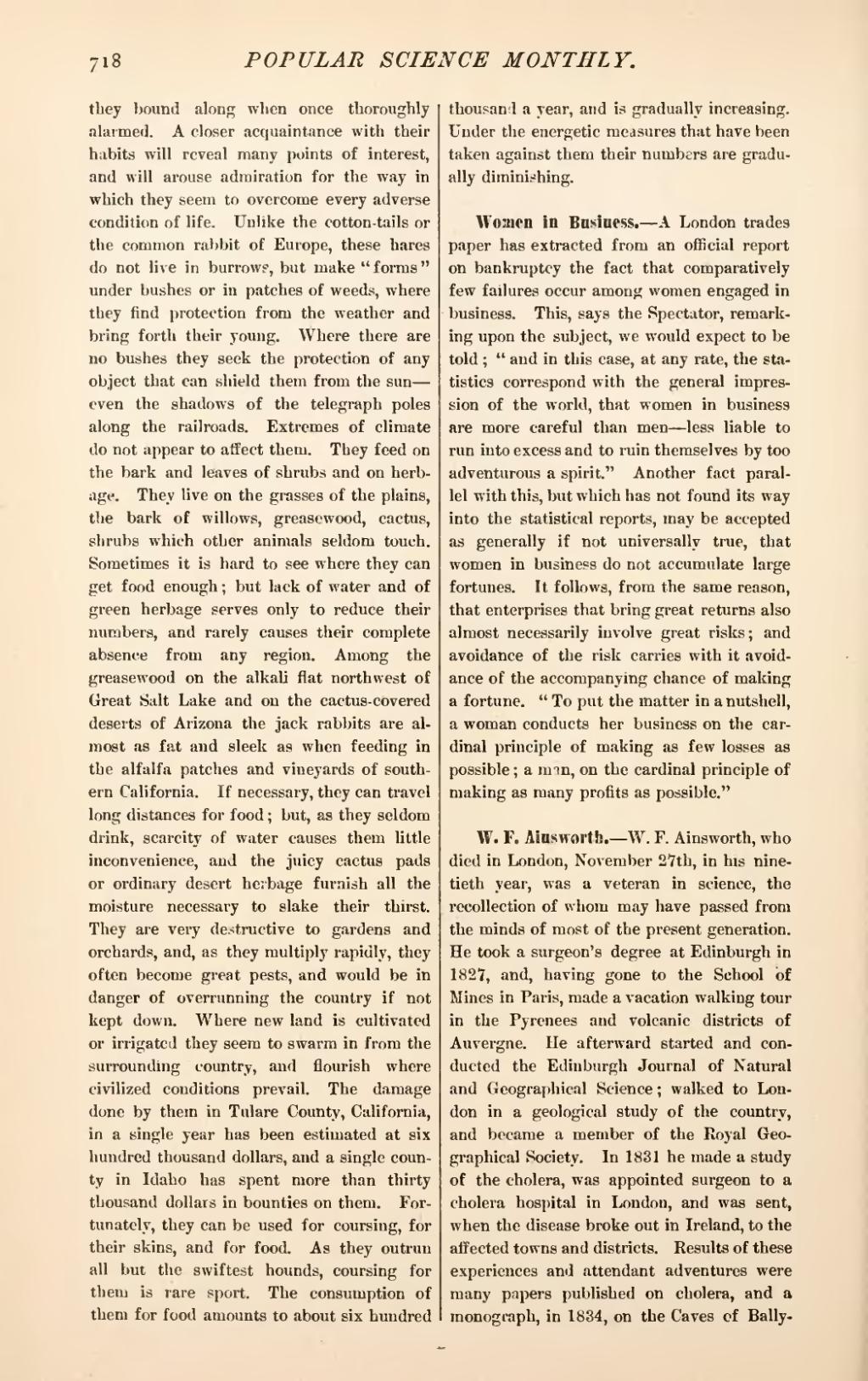they bound along when once thoroughly alarmed. A closer acquaintance with their habits will reveal many points of interest, and will arouse admiration for the way in which they seem to overcome every adverse condition of life. Unlike the cotton-tails or the common rabbit of Europe, these hares do not live in burrows, but make "forms" under bushes or in patches of weeds, where they find protection from the weather and bring forth their young. Where there are no bushes they seek the protection of any object that can shield them from the sun—even the shadows of the telegraph poles along the railroads. Extremes of climate do not appear to affect them. They feed on the bark and leaves of shrubs and on herbage. They live on the grasses of the plains, the bark of willows, greasewood, cactus, shrubs which other animals seldom touch. Sometimes it is hard to see where they can get food enough; but lack of water and of green herbage serves only to reduce their numbers, and rarely causes their complete absence from any region. Among the greasewood on the alkali flat northwest of Great Salt Lake and on the cactus-covered deserts of Arizona the jack rabbits are almost as fat and sleek as when feeding in the alfalfa patches and vineyards of southern California. If necessary, they can travel long distances for food; but, as they seldom drink, scarcity of water causes them little inconvenience, and the juicy cactus pads or ordinary desert herbage furnish all the moisture necessary to slake their thirst. They are very destructive to gardens and orchards, and, as they multiply rapidly, they often become great pests, and would be in danger of overrunning the country if not kept down. Where new land is cultivated or irrigated they seem to swarm in from the surrounding country, and flourish where civilized conditions prevail. The damage done by them in Tulare County, California, in a single year has been estimated at six hundred thousand dollars, and a single county in Idaho has spent more than thirty thousand dollars in bounties on them. Fortunately, they can be used for coursing, for their skins, and for food. As they outrun all but the swiftest hounds, coursing for them is rare sport. The consumption of them for food amounts to about six hundred thousand a year, and is gradually increasing. Under the energetic measures that have been taken against them their numbers are gradually diminishing.
Women in Business.—A London trades paper has extracted from an official report on bankruptcy the fact that comparatively few failures occur among women engaged in business. This, says the Spectator, remarking upon the subject, we would expect to be told; "and in this case, at any rate, the statistics correspond with the general impression of the world, that women in business are more careful than men—less liable to run into excess and to ruin themselves by too adventurous a spirit." Another fact parallel with this, but which has not found its way into the statistical reports, may be accepted as generally if not universally true, that women in business do not accumulate large fortunes. It follows, from the same reason, that enterprises that bring great returns also almost necessarily involve great risks; and avoidance of the risk carries with it avoidance of the accompanying chance of making a fortune. "To put the matter in a nutshell, a woman conducts her business on the cardinal principle of making as few losses as possible; a rain, on the cardinal principle of making as many profits as possible."
W. F. Ainsworth.—W. F. Ainsworth, who died in London, November 2'7th, in his ninetieth year, was a veteran in science, the recollection of whom may have passed from the minds of most of the present generation. He took a surgeon's degree at Edinburgh in 1827, and, having gone to the School of Mines in Paris, made a vacation walking tour in the Pyrenees and volcanic districts of Auvergne. He afterward started and conducted the Edinburgh Journal of Natural and Geographical Science; walked to London in a geological study of the country, and became a member of the Royal Geographical Society. In 1831 he made a study of the cholera, was appointed surgeon to a cholera hospital in London, and was sent, when the disease broke out in Ireland, to the affected towns and districts. Results of these experiences and attendant adventures were many papers published on cholera, and a monograph, in 1834, on the Caves of Bally-
